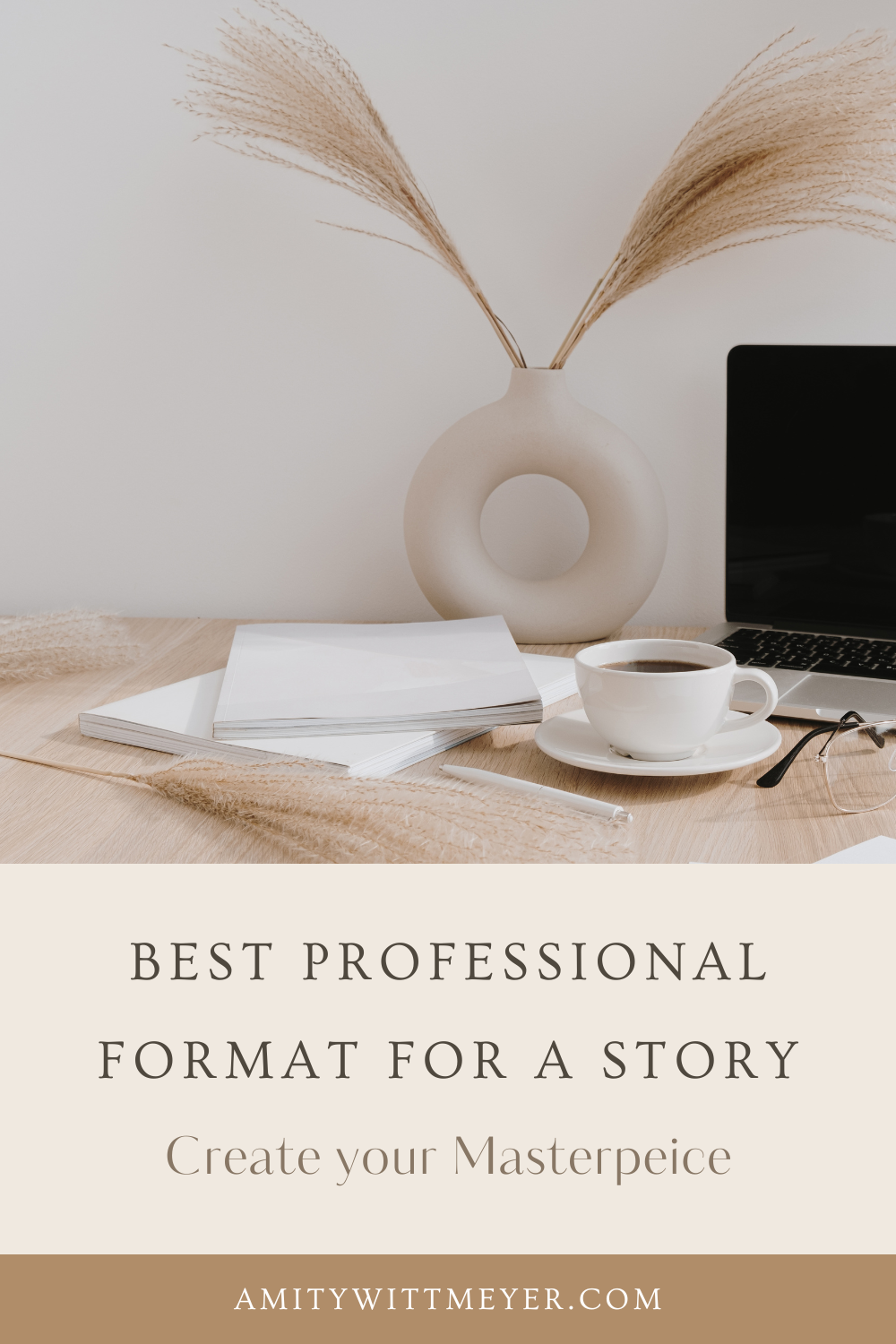Disclaimer: This post may contain affiliate links, which means we may receive a commission at no cost to you if you make a purchase through a link below.
Want to have a professional format for your first novel? Your ideas are just a start; formatting a story follows a careful formula.
So you’re ready to get started on your first writing project, but you’re unsure of how to format a story. Look no further! By the end of this blog post, you’ll be able to organize your ideas in a professionally written layout successfully.
The Beginning
For starters, your format has to begin…with a beginning. Furthermore, whether you are writing a short story or a novel, you need to have a beginning in your format. The begin
ning lays the foundation of your story, including its location, time period, central drive, and your characters.
- The Hook
Firstly, you need a hook, or a compelling start that keeps your reader’s attention. For example, jumping right into an action-packed event, introducing a character, and showing an issue
, creating a cliffhanger, stating a question you will be trying to answer, or any unusual situation.
Most people pick up a book or short story, read the first page, then decide if they’ll put the book down or read on. Your first page is crucial. Format your story so you jump into the action immediately. You shouldn’t give too much away, yet you need to let the reader get a taste of what they’re in for.
Karpovich, V. Content young businesswoman using laptop while taking tea cup at home. Pexels.com. https://www.pexels.com/photo/content-young-businesswoman-using-laptop-while-taking-tea-cup-at-home-4050350/
As a result, this page should be very well thought-out. Take your time, and I recommend going back and rewriting it after you have completed writing your entire story.
2. A Note on Pacing
A 2016 research article titled “READING AND WRITING IN THE AGE OF SHORT ATTENTION SPANS,” created by the 8th International Conference on Education and New Learning Technologies, notes that
“Short attention spans essentially means that the nature of reading has changed. We have lost patience with the complexity that words present and do not find them worth capturing or holding onto anymore (…) The mind is now accustomed to take in information the way the Internet distributes it: in a swiftly moving stream of images.”
With “doom scrolling” at an all-time high, are we getting smarter? Or are we all too distracted to realize our attention spans are depleting? Reading is a soft stimulation that not only helps with learning, but also your ability to delay instant gratification and reprogram your brain to be patient and enjoy using your imagination.
However, today, short-form videos are all the craze. So, as a writer, you should not work against what this means to your present reader. Instead, you need to acknowledge that you may already be at a disadvantage since your audience has limited attention spans.
Therefore, your first page, where you format your hook to keep your reader reading, is vital. It has to display perfectly what sort of story your reader can expect. It should be action-packed, emotional, or even a little disturbing.
You do not need to dumb down your material and change your writing style. You do need to get to the point. Stories from the past usually have a long introduction formatted in their first chapter. Sometimes, the story doesn’t introduce the main characters or plot till multiple chapters in.
While that may have worked one hundred years ago, today is a different story, and I highly encourage you to jump right into the drama on page one.
3. Inciting Incident
An inciting incident is an event that challenges your character or characters. The event needs to be something out of the ordinary for your character to propel them into your story.
Here are some examples of novels I recommend you read to see a good example of attention-grabbing inciting incidents. Grow your bookshelf of quality pieces of writing now.
- Think of Katniss volunteering as a tribute in The Hunger Games,
- Jack Torrence becoming the caretaker for the Overlook Hotel in The Shining
- Celie getting married off to an abuser in The Color Purple,
- A group of boys crash-land on an island in Lord of the Flies, etc.
You get the idea. Make sure to check out these novels for your next read.
The Middle
The middle of your story should be formatted into three separate points: First plot point, midpoint, and third plot point.
-
- First Plot Point
Starting off, the first plot point is when everything changes for the protagonist. This event branches off from the inciting incident, which gets your character into the action and, therefore, creates a whole new challenge they need to overcome.
Ultimately, the first plot point’s format sets the scene for a strange or unusual event that threatens the chances of the protagonist going back to their normal routine. Just like the famous song in The Phantom of the Opera, this is “the point of no return.” In conclusion, this will solidify the character’s objective, displaying not only their goal but also the obstacles now standing in their way.
Two books I recommend reading to see well-formatted first plot points are To Kill a Mockingbird and Farenheight 451.
The first plot point in To Kill a Mockingbird is when Atticus agrees to defend Tom Robinson in court against a white woman, pushing the Finch family into their town’s racial prejudice. Another example is Guy Montag meeting Clarisse, who makes him begin to challenge his society’s beliefs in Farenheight 451.
Expand your understanding and pick up a copy.
-
- Midpoint
Next, your story’s format just includes the midpoint. The midpoint in the middle of your story is where your protagonist now jumps into action. In consequence, this event prompts them to fight or further pursue their goal. The midpoint is your story’s center.
Here is where the magic happens that will thrust your story into its second half. The plot, characters, and obstacles have all been introduced, and now it’s time to throw your reader into some action.
My next set of recommended books to demonstrate professional formatting skills is Animal Farm and The Help. Both are highly praised novels, for good reason, and their format has helped allow the writing’s longevity.
For example, the destruction of the first windmill in Animal Farm finally highlights Napoleon’s corruption and reveals to the farm animals the fall of justice in their lives. Or in The Help, when Skeeter finds a way to publish Aibileen’s stories to advocate for equality by revealing the hardships black maids faced in the 1960s. Both examples demonstrate the call to action to either stop a bad situation or right a wrong.
-
- Third Plot Point
Finally, the third plot point is the last section, formatted in the middle of the story. Therefore, it needs to push the story into the end segment. Usually, this is the lowest point for your protagonist: a step back from their goal. This event is crucial for your story and your character’s development.
It is important to format your third plot point by building up to the disaster and getting your reader to believe your character will either succeed or fail.
The third plot point marks a failure, making your protagonist have to confront the consequences of their actions or the beliefs they have held thus far. Your character needs to fail to come out the other end having learned a lesson, changed a mindset, and ultimately become more driven to complete their goal.
Not all stories have protagonists that are “good” or moral. Your character doesn’t need to end up a hero or savior. They do have to be challenged externally and internally through the circumstances you put them in. Here is their ultimate test. This event has to finally allow them to see what needs to be done to resolve their conflict.
By the end of this event, your character should realize what must be done so that their mistake does not happen again. I recommend you read Wuthering Heights if you’re into tragic love stories set in 1800s England. The novel also has a very interesting format, jumping timelines and character perspectives multiple times throughout.
The third plot point is when Heathcliff’s vengefully manipulates Catherine and Linton’s marriage in Wuthering Heights. This event eventually leads to the death of his son, Linton, and catapults Heathcliff into despair until he eventually dies too.
In summary, the event forces Heathcliff to look inwardly at his pain and either solve his broken heart or continue to remain miserable, in denial, and continually placing blame on others rather than himself. His choice is obvious.
The End
Wrapping it up, the ending of your story is formatted into two: the climax and the resolution.
-
- The Climax
The climax is the moment in your story where action is at its peak. Here, your protagonist must finally face the antagonist. The antagonist could be a villain, a society, a belief, or even themself.
There should be a struggle, a battle, or even a sacrifice made during this time in your story. Your central conflict that your story has been following should be faced and possibly resolved here. The climax is a turning point and often the most exciting part of your story. It also jolts your story to finally being resolved.
Jumping back into recommendations, if you haven’t yet, you should read Frankenstein by Mary Shelley (the very first science fiction novel). Frankenstein has an incredible format, switching perspectives three times, and is mostly told through letters the characters wrote.
Now, for the climax in the novel, Victor murders the Creature’s new bride on their wedding night, causing the Creature to act out violently, which leads to the chase sequence, bringing the story full circle.
I also recommend Catch-22 for your next read. A satirical war story that has excellent comedic timing and symbolism. The climax in this story is the traumatic death of Snowden, causing Yossarian to grow in his awareness of the horrors of war and his pursuit to escape.
-
- The Resolution
Next, the resolution is the final event and closing of your story. There are three key elements to include when formatting your story’s wrap-up.
According to the article “Resolution of a Story: How to Write the Resolution” of a Story by MasterClass, you need to resolve your story’s main conflicts, complete the arcs of your characters, and answer any lingering questions. This doesn’t mean you can’t have a cliffhanger, which works best if this story is in a series.
However, formatting your ending is crucial to your story’s overall impact on your reader. The ending is usually the most memorable part because it took the entire story to reach it. It should be well thought out and, in many ways, a satisfaction of your hard work.
If your ending is rushed, the story will lose its value. It will become sloppy, NOT PROFESSIONAL, and your reader will not be kind in its evaluation.
If you have created symbolism throughout your story, why not reveal its meaning here? If characters have always dreamed of something happening, why not make that happen?
Naturally, some readers will skip to the end of the story and read the last page or sentence. IN consequence, the ending should be as well thought-out and attention-grabbing as your hook on your first page. No one likes a story that simply…ends. Problems need to be finally solved, characters get their rightful ending, and obstacles are finally surpassed.
The ending also reveals a new status quo that replaces the general goal the story followed thus far. Maybe your character settled down and now faces the challenge of being a parent. Or, perhaps, they discovered a new threat that was uncovered after the last one was solved.
The best part of writing is giving your reader permission to imagine. The ending is the best place for them to take your words and interpret how they wish the characters they have learned to know finish their story.
Give them something to feed that imagination. Don’t disappoint them with lazy writing!
Some memorable endings are the ones people least expect, yet grab the reader’s attention to imagine for themselves what the continuation of the story would look like for your characters.
Endings do not have to be happy, but their format does have to clear things up.
A novel with a sad ending I recommend is The Secret History. This novel proves you can have successful stories formatted to end tragically. I remember crying profusely after reading the tragic ways each character dealt with the murder of their friend, which they had committed.
A novel with a very satisfying, happily formatted ending is Rita Hayworth and the Shawshank Redemption. Andy escapes and gets his dream of freedom and the ocean realized. I couldn’t stop smiling after completing it, the words “I hope, I hope” lingering in my head for hours.
Books and stories hold intense messages and can impact generations. It is always their ending that changes a good story into a classic.
Remember your audience, but also remember that writing is a gift you are bringing to yourself. Write something worthy of YOUR attention in its revising and rereading.





